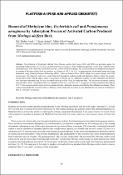Options
Removal of Methylene blue, Escherichia coli and Pseudomonus aeruginosa by Adsorption Process of Activated Carbon Produced from Moringa oleifera Bark
Date Issued
2020-12-25
Author(s)
Md. Shahin Azad
Syaza Azhari
Mohd Sukri Hassan
Abstract
The utilization of biopolymer derived from Moringa oleifera bark using ZnCl2 and H2SO4 as activating agents for eliminating methylene blue, Escherichia coli and Pseudomonas aeruginosa from producing wastewater. In this study, methylene blue and both bacteria were effectively adsorbed by activated carbon with lowest dosage. The activated carbon was prepared from natural by product of Moringa oleifera bark by pyrolysis in a furnace at 700 °C for 1 h. The characteristics of activated carbon have been determined using Scanning Electron Microscopy (SEM), Brunauer-Emmett-Teller (BET), pHzpc (zero point charge), and FTIR spectroscopy. The obtained result were closely fitted with Freundlich isotherm model and adsorption kinetics follow the pseudo second order model with the highest value of correlation coefficient (R2~1). Adsorption quantity was dose dependent and bacteria were maximum adsorbed using 10 mg of activated carbon as well as 25 mg for methylene blue. The maximum adsorption capacity showed within 1 hour. The bacterial cells were reduced by 98 % for E. coli, 96 % for P. aeruginosa as well as methylene blue reduced 94.2 % from aqueous solution using batch adsorption methods. Adsorption process controlled by film diffusion mechanism. These results proposed that the activated carbon of Moringa oleifera bark can be used as a good adsorbent for the removal of Methylene blue, E. coli and P. aeruginosa.
Subjects
File(s)
Loading...
Name
Removal of Methylene blue, Escherichia coli and Pseudomonus aeruginosa by Adsorption Process of Activated Carbon Produced from Moringa oleifera Bark.pdf
Size
512.85 KB
Format
Adobe PDF
Checksum
(MD5):428a9c657dae1c31cb400ae2084e5a5e